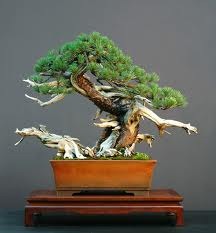How Can I Prevent Pests & Disease? – When working to prevent the possible injury or death of your beloved bonsai, the best defense is a strong offense: be vigilant by keeping your bonsai clean, dust and debris free and cleared of fallen leaves and flowers; be sure sufficient lighting is supplied, as well as, good ventilation and lots of fresh air. A healthy bonsai is without a doubt the most important preventative of pests and disease.
How Can I Treat Pests & Disease? – Unfortunately, even the most observant bonsai enthusiast is likely to encounter some type of pests or disease during their endeavors. It is healthier for your bonsai to be treated for pests and diseases in incremental steps of increasing toxicity.
The first thing to try to change is your bonsai’s current environment. This technique is the simplest and safest. Quite often a change of location can help an ailing bonsai and if it does not, at the very least, you know that your bonsai’s problem is probably not environmental.
The second incremental step would be to try, if possible, to introduce biological controls such as ladybugs. Ladybugs are of no danger to your bonsai and they will eat nearly all pests that are. Of course, this technique is limited to outdoor locations.
The third incremental step would be to use chemicals, also in levels of increasing toxicity. To start, you can try spraying a very mild solution of warm water and liquid dish soap on your trees. This technique is an excellent way to prevent a wide variety of diseases and helps in discouraging many types of pests. Multiple applications may be required to achieve and maintain a healthy bonsai, but the rewards will far out-weigh the efforts.
The fourth incremental step would be to try using a mild insecticidal soap such as the brand name: Safer. This multi-purpose soap derivative offers effective control over most pests. This type of insecticide is one of the mildest and safest, for humans, animals and bonsai – something of a vital importance, especially if you have children and pets.
The incremental step of "last resort" would be to use an actual "chemical" spray, such as: Schultz’s insecticide. It should be handled carefully and used as per manufacturer’s recommendations.
An Additional Note About Pests & Disease? – When and if you find yourself staring at an unwanted visitor to your bonsai, remain calm and then picked up the phone and call your local bonsai supplier or a local bonsai enthusiast and ask for experienced advice. Your visitors will leave sooner and your bonsai will live longer.
BONSAI CONTAINERS
What Kind Of Container Should You Use? – The answer to this question depends upon the function of the container itself. Fundamentally, there are two kinds of bonsai pots: training pots and display pots. If your bonsai is in the training stage, then the pot you need to use is a functional training pot. Training pots are available made of plastic, mica, and even wood. Mica training pots are my personal favorite, as they are available in very large sizes at very reasonable prices. Nevertheless, there are many options and here at Bonsai Boy Nursery we have them all here for you to choose from. At this critical stage in the development of your bonsai, the most important thing is that you use a pot that is practical. It must reasonably and safely hold all of the soil or growing media that is required to provide the space for a healthy and stable root system to develop, good branching and the desired trunk thickness.
It is essential that any bonsai pot have large drainage holes to insure no water gets trapped at the bottom of the pot, because waterlogged roots will rot and be fatal for your bonsai.
Your bonsai will never really be ready for a display pot without all of these vital development stages having already taken place in a training pot.
What Types Of Containers Are Most Appropriate? – If your bonsai is fully developed to your complete satisfaction and you are preparing to show it, then it is definitely time to choose a display pot. Display pots are usually ceramic, because they must be frost proof, and are available with either a glaze or an unglazed finish. The most suitable display pot is one that enhances and not overshadows the beauty of your prized bonsai.
The most appropriate type of pot is an aesthetic, as well as, an able consideration and depends largely on the type of bonsai you are displaying and its horticultural requirements. The beauty of a deciduous or flowering bonsai is greatly enhanced when matched with a glazed pot of a soft, attractive color, such as: light blue, cream, or green. Conifer and evergreen bonsai when paired with an unglazed pot of an austere color, such as: brown, gray or reddish clay, are perceived in a way that reflects the severe environment of their natural habitat.
The length of your bonsai pot should be in direct relation to the height of your bonsai. A tall bonsai, in general, requires a long pot. In conjunction, the depth of your pot should be relative to the thickness of your bonsai’s trunk. A thick trunk usually commands a deeper pot.
Of course, size guidelines are just that – guidelines. The needs of your specific variety of bonsai will dictate, for the most part, the size of the display pot you can safely utilize.
How Are Pots Pertinent? – The most pertinent feature of pots is that their form must follow their function. If a pot cannot sustain your bonsai, then it really doesn’t matter how good it looks, because it will soon be empty.


Deprecated: strpos(): Passing null to parameter #1 ($haystack) of type string is deprecated in /home/agriviek8Qv/agriviet.net/public_html/wp-includes/comment-template.php on line 2522